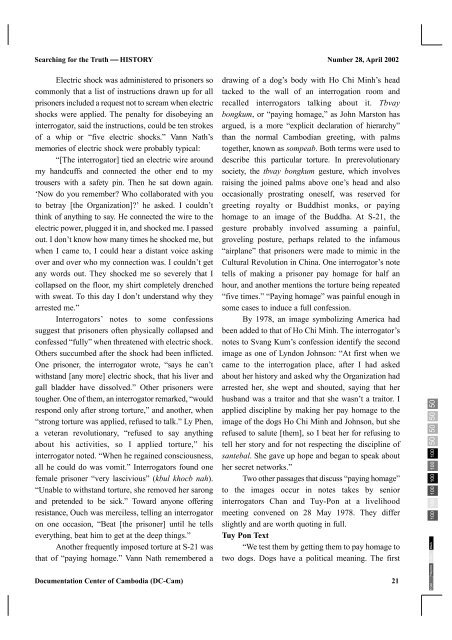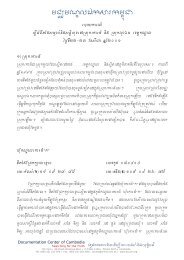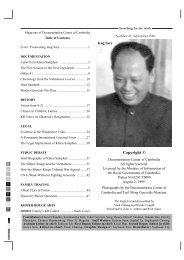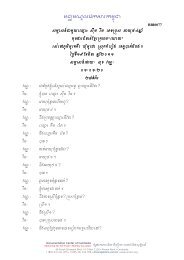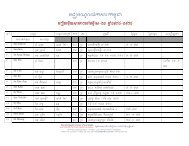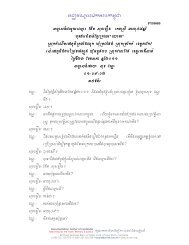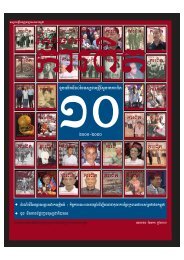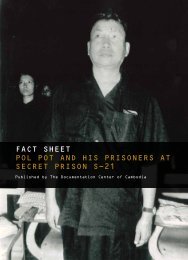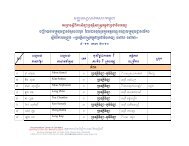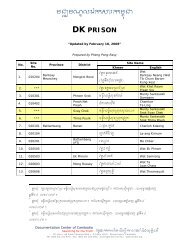Searching for the truth Issues 28 - Documentation Center of Cambodia
Searching for the truth Issues 28 - Documentation Center of Cambodia
Searching for the truth Issues 28 - Documentation Center of Cambodia
You also want an ePaper? Increase the reach of your titles
YUMPU automatically turns print PDFs into web optimized ePapers that Google loves.
<strong>Searching</strong> <strong>for</strong> <strong>the</strong> Truth ⎯ HISTORY<br />
Electric shock was administered to prisoners so<br />
commonly that a list <strong>of</strong> instructions drawn up <strong>for</strong> all<br />
prisoners included a request not to scream when electric<br />
shocks were applied. The penalty <strong>for</strong> disobeying an<br />
interrogator, said <strong>the</strong> instructions, could be ten strokes<br />
<strong>of</strong> a whip or “five electric shocks.” Vann Nath’s<br />
memories <strong>of</strong> electric shock were probably typical:<br />
“[The interrogator] tied an electric wire around<br />
my handcuffs and connected <strong>the</strong> o<strong>the</strong>r end to my<br />
trousers with a safety pin. Then he sat down again.<br />
‘Now do you remember? Who collaborated with you<br />
to betray [<strong>the</strong> Organization]?’ he asked. I couldn’t<br />
think <strong>of</strong> anything to say. He connected <strong>the</strong> wire to <strong>the</strong><br />
electric power, plugged it in, and shocked me. I passed<br />
out. I don’t know how many times he shocked me, but<br />
when I came to, I could hear a distant voice asking<br />
over and over who my connection was. I couldn’t get<br />
any words out. They shocked me so severely that I<br />
collapsed on <strong>the</strong> floor, my shirt completely drenched<br />
with sweat. To this day I don’t understand why <strong>the</strong>y<br />
arrested me.”<br />
Interrogators’ notes to some confessions<br />
suggest that prisoners <strong>of</strong>ten physically collapsed and<br />
confessed “fully” when threatened with electric shock.<br />
O<strong>the</strong>rs succumbed after <strong>the</strong> shock had been inflicted.<br />
One prisoner, <strong>the</strong> interrogator wrote, “says he can’t<br />
withstand [any more] electric shock, that his liver and<br />
gall bladder have dissolved.” O<strong>the</strong>r prisoners were<br />
tougher. One <strong>of</strong> <strong>the</strong>m, an interrogator remarked, “would<br />
respond only after strong torture,” and ano<strong>the</strong>r, when<br />
“strong torture was applied, refused to talk.” Ly Phen,<br />
a veteran revolutionary, “refused to say anything<br />
about his activities, so I applied torture,” his<br />
interrogator noted. “When he regained consciousness,<br />
all he could do was vomit.” Interrogators found one<br />
female prisoner “very lascivious” (kbul khocb nah).<br />
“Unable to withstand torture, she removed her sarong<br />
and pretended to be sick.” Toward anyone <strong>of</strong>fering<br />
resistance, Ouch was merciless, telling an interrogator<br />
on one occasion, “Beat [<strong>the</strong> prisoner] until he tells<br />
everything, beat him to get at <strong>the</strong> deep things.”<br />
Ano<strong>the</strong>r frequently imposed torture at S-21 was<br />
that <strong>of</strong> “paying homage.” Vann Nath remembered a<br />
<strong>Documentation</strong> <strong>Center</strong> <strong>of</strong> <strong>Cambodia</strong> (DC-Cam)<br />
Number <strong>28</strong>, April 2002<br />
drawing <strong>of</strong> a dog’s body with Ho Chi Minh’s head<br />
tacked to <strong>the</strong> wall <strong>of</strong> an interrogation room and<br />
recalled interrogators talking about it. Tbvay<br />
bongkum, or “paying homage,” as John Marston has<br />
argued, is a more “explicit declaration <strong>of</strong> hierarchy”<br />
than <strong>the</strong> normal <strong>Cambodia</strong>n greeting, with palms<br />
toge<strong>the</strong>r, known as sompeab. Both terms were used to<br />
describe this particular torture. In prerevolutionary<br />
society, <strong>the</strong> tbvay bongkum gesture, which involves<br />
raising <strong>the</strong> joined palms above one’s head and also<br />
occasionally prostrating oneself, was reserved <strong>for</strong><br />
greeting royalty or Buddhist monks, or paying<br />
homage to an image <strong>of</strong> <strong>the</strong> Buddha. At S-21, <strong>the</strong><br />
gesture probably involved assuming a painful,<br />
groveling posture, perhaps related to <strong>the</strong> infamous<br />
“airplane” that prisoners were made to mimic in <strong>the</strong><br />
Cultural Revolution in China. One interrogator’s note<br />
tells <strong>of</strong> making a prisoner pay homage <strong>for</strong> half an<br />
hour, and ano<strong>the</strong>r mentions <strong>the</strong> torture being repeated<br />
“five times.” “Paying homage” was painful enough in<br />
some cases to induce a full confession.<br />
By 1978, an image symbolizing America had<br />
been added to that <strong>of</strong> Ho Chi Minh. The interrogator’s<br />
notes to Svang Kum’s confession identify <strong>the</strong> second<br />
image as one <strong>of</strong> Lyndon Johnson: “At first when we<br />
came to <strong>the</strong> interrogation place, after I had asked<br />
about her history and asked why <strong>the</strong> Organization had<br />
arrested her, she wept and shouted, saying that her<br />
husband was a traitor and that she wasn’t a traitor. I<br />
applied discipline by making her pay homage to <strong>the</strong><br />
image <strong>of</strong> <strong>the</strong> dogs Ho Chi Minh and Johnson, but she<br />
refused to salute [<strong>the</strong>m], so I beat her <strong>for</strong> refusing to<br />
tell her story and <strong>for</strong> not respecting <strong>the</strong> discipline <strong>of</strong><br />
santebal. She gave up hope and began to speak about<br />
her secret networks.”<br />
Two o<strong>the</strong>r passages that discuss “paying homage”<br />
to <strong>the</strong> images occur in notes takes by senior<br />
interrogators Chan and Tuy-Pon at a livelihood<br />
meeting convened on <strong>28</strong> May 1978. They differ<br />
slightly and are worth quoting in full.<br />
Tuy Pon Text<br />
“We test <strong>the</strong>m by getting <strong>the</strong>m to pay homage to<br />
two dogs. Dogs have a political meaning. The first<br />
21<br />
100 100 100 100 100 100 50 50 50 50<br />
Black<br />
Yellow<br />
Magenta<br />
Cyan


